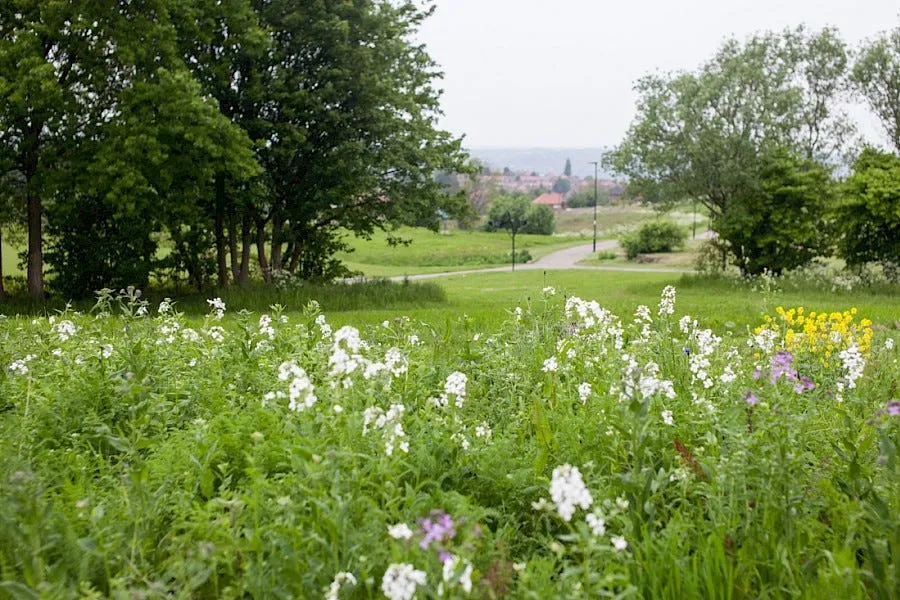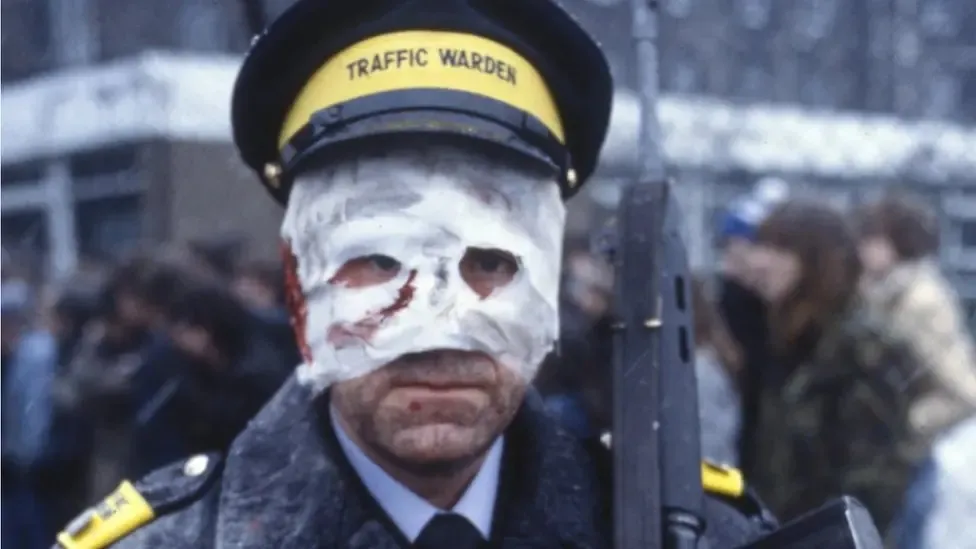“What bloody more could you ask for?” says Roy, panting and doubled over into a recovery position on a bench on Manor Top. We look down on the sweeping panoramic view of Sheffield and beyond. It’s impressive. He’s just completed his “Manor lap”, a trademark run around the area and its parks that he does every month or so. After a gulp of water, he jokes: “I wouldn’t put myself through this anywhere else, that’s for sure.”
Roy moved out of Sheffield a decade ago and lives half an hour away, but still returns here regularly for his favourite run. His comments don’t exactly fit with the image of a decaying post-industrial wasteland my week of preparatory Google searches had warned me of. Indeed, the first task with the Manor seems to be untangling the reality from the myth.
In April 2007, the Mirror painted the area as a typical “hoodies and ASBOs” council estate. “THIS IS OUR MANOR” screamed the title, accompanied by an image of aggressive looking people, feral children and a big scary dog. Throughout the piece, old dears cower in the sanctuary of their dilapidated homes as neanderthal yobs spit, shout, swear, wield sticks and play “rap music” as an intimidation tactic, like the giants from the BFG with a boombox and a penchant for Dizzee Rascal.

Nine years later, in 2016, The Sun was still calling the Manor a “no go estate” in a piece that referred to MP Roy Hattersley’s infamous 1995 comment that the estate was the “worst in Britain” (the paper later retracted the piece after an appeal by the local MP). But even the Guardian followed up a few months later in virtual agreement, only applying the slight caveat that the redtop had been over-zealous in their assertions: “It is far from the worst even in Sheffield,” claimed the author.
30 years earlier, in 1986, Channel Four’s On the Manor charted the decline of an estate which at its inception had been a source of pride for Sheffield. Built in the late 1920s and early 1930s as a ‘Garden City’ development to counteract overcrowding in the centre of the city, the Manor offered a semi-rural sanctuary up and away from the inner-city slums.
“Well, it’s not same, is it?” says a woman in the documentary, literally standing at her kitchen sink, comparing what the estate was like in its glory days with what it had turned into by the mid-1980s. Later, we see the bulldozing of a chimney and the gutted husk of an abandoned steel works, workplaces which housed many thousands of workers from the Manor in Sheffield’s industrial era heyday.

The documentary is a kind of cultural antecedent to the mid-noughties poverty-porn genre, which many of these tabloid tales of woe are evidently riffing on. All of which is to say, the media hasn’t looked kindly on the Manor over the years.
So when the admin of the Manor Estate Facebook Group announces my interest in writing a piece about the area to the membership, there’s understandable trepidation. One reply says that it depends what my motivations are because when previous journalists have written about the area they’ve made it seem “like Beirut.” I’m allowed in, but with caution.
Dawn Dale has lived on the Manor since 1996. She believes the stereotypes come from people’s ignorance of the cycles of poverty caused by the collapse of Sheffield’s major industries in the late 70s and early 80s. As the original purpose of the estate was to house the people who worked in heavy industry, it’s unsurprising it would struggle when that sector suffered such a precipitous decline. A community forged on metal and manufacturing went from full employment to almost one in three being out of work in just a few short years, and the area is still suffering the effects to this day.

Dawn tells me she’s grown accustomed to the same tiresome comments when she mentions where she lives. “Ooh, a Manor lass be careful,” she says, in a mock-obnoxious voice. “People have this vision of a Shameless-type environment,” she continues. “They want to make us look like the lowest of the low.”
But Dawn is eager to help change the face of her community. As well as being a city councillor for the nearby ward of Shiregreen and Brightside, she’s also a Sure Start ambassador on the Manor. This programme, set up by the last Labour government in 1998, works with children under four in disadvantaged areas to promote health and education. Dawn waxes lyrical about the effectiveness of the programme in embedding confidence in children that lasts throughout their education. Where many of the local schools were once failing, attainment in the area is now the best it’s ever been.

Another organisation working to change perceptions of the area is the Manor and Castle Development Trust. CEO Debbie Matthews tells me that trust was initially borne out of community activism in response to the reputation it had, triggered in particular by the Hattersley remark. Just a year later, in 1996, a funding bid was submitted to the government for a seven year programme of regeneration.
The programme ran between 1997 and 2004, pumping roughly £16 million into the area. Much of this was invested in education, health and infrastructure, but there was also a focus on restoring community green spaces. This was done via the Green Estate, a sister company of the trust, who have worked to regenerate several local parks and build additional “pocket parks” to improve the area.
In some ways this was an attempt to revive the Garden City vision of Manor’s interwar years. Nowadays, the jewel in the area’s crown is Manor Fields Park. Once a tired and forgotten wasteland, it has been the focus of extensive work by the Green Estate and is now a much-loved community asset. The park has Green Flag status and plays host to various events including a weekly parkrun and annual bonfire that attracts up to 6,500 attendees.

Since I was allowed into the Manor Estate Facebook Group my wall has been peppered by Manor Fields events of various kinds. In the space of a few weeks I see Halloween fun days, wild creative writing, women’s bike riding and more. To Debbie, the importance of these kind of events cannot be overstated. She recalls speaking to a family who had to save up for a day trip to Matlock. “It’s shocking really,” she says. “That’s why it’s so important to have nice things for families to do here in their own community.”
But despite this, when I ask whether these developments will eventually shift the dominant narratives that characterise the Manor in the popular imagination, she isn’t convinced. “I really don’t know the answer to that,” she says. “The media that’s been whipped up has left lasting perceptions and it's hard to change that.”
As part of an in-depth historiography of the area, the social housing blog Municipal Dreams details a series of half-baked regeneration attempts across the Manor’s years of decline. One of these was the Manor Employment Project between 1981 and 1987, which author John Boughton says had “some positive impact but provided very little permanent employment and suffered numerous conflicts and tensions.”

Nowadays, the development trust works with the Manor Training and Resource Centre (MaTReC), whose goal is to help residents to develop skills to gain work in modern job sectors, particularly those who are currently furthest from employment. Far more effective than any of the 1980s projects, it focuses on maths and English GCSEs or basic IT training and has been key for the area in recreating jobs and charting an existence post-steel.
There have also been ongoing attempts to modernise the housing on the Manor. This began in the 1980s, when it became apparent that many of the original homes, known as “Boot Houses” after the developer Henry Boot, were found to be structurally unfit for purpose. A scheme was developed to knock down and rebuild many of the houses that couldn’t be salvaged, although far more knocking down was done than rebuilding at this initial stage — a function of the then-thinning population.
Walking round the estate, some elements of the old Manor can still be seen, but they are few and far between. In an underpass, the words “comply or die” are scrawled somewhat amusingly opposite a “Build Better Community” mural featuring images of playing children and other pleasant scenes. In some foliage, a mini tribute to Anthony Sumner, who was stabbed to death here in an attack in July reads: ‘RIP ANTHONY, OLD SKOOL RUDE BOY, FLY FREE.”

But despite occasional reminders of the violence the estate still sees, as I walk through, even later in the evening, there’s little sense of unease. I go down several streets of extremely smart new builds, part of a modernisation programme that has changed the face of the Manor over the last three decades. Outside one of them I meet 32-year-old Matthew Anthony, who moved here about a year ago.
While he sometimes gets a “bit of a dodgy feeling” walking around the estate at night, he and his family feel mostly safe on the estate. Matthew’s partner tells me how much better her daughter’s school here has been than the one she attended previously. I ask whether she ever fears for her daughter being out and about by herself. “I do get worried but I would anywhere, we’ve not had any trouble,” she replies.
She’s also keen to stress the tightness of the community she lives in. “We know all our neighbours and everyone checks in on everyone,” she explains. “You go to some areas and nobody knows who their neighbours are.”

Matthew tells a story from a few months back when a group of lads caused a house fire after letting off fireworks that shot by accident through a family’s front window. Despite rumours that the act was intentional, Matthew’s main takeaway was how quickly people came together. “Probably around 15 people came out onto the street and a couple of women went knocking on doors getting people to help,” he says. “People were all on it quite quickly.”
Almost everyone I speak to has an acute awareness and frustration at the reputation of their home and a keenness to stick up for themselves. Dawn tells me how they successfully challenged the aforementioned Sun article five years ago, which again described the Manor estate as “the worst in Britain,” and falsely identified it as a target for David Cameron’s plans to tear down and rebuild “sink estates.” The Sun blamed a “junior and inexperienced” journalist for the mistake, saying he had relied on archival information, rather than bothering to visit.
She also recalls seeing the estate on the programme Police Camera Action! a while back. “We are now driving through the notorious Manor estate,” she says in her best TV presenter’s voice. “But it wasn’t even the Manor, it was Parson Cross! This is the language they always use to describe us: notorious or infamous. We need a massive change in this country to shake these attitudes off.”

Night falls and I start to make my way back down through the estate. I’ve failed to encounter any man-eating canines or stick-wielding yobs but I don’t feel cheated. Instead, an assortment of skeletons, grim reapers and witches shuffle from house to house on their trick or treating rounds. I speak to a woman as she watches her children collect sweets from the roadside.
She’s “a bit iffy” when it comes to speaking with the press (“we’ve had our fingers burnt more than enough, thank you very much”), so prefers to remain nameless. But she does tell me that the Manor is not like some other parts of Sheffield, where “venturing past the bloody door was like putting your life on the line”. One Halloween on another estate she recalls missiles and all manner of objects hitting her windows because a group of kids thought it was funny. “Stones, bits of mud, a chocolate bar!” she says. “It sounds daft but it wasn’t nice at all.”
“That’s not to say I’ve not seen silliness here,” she continues. “But for the most part, this is a decent community that looks out for you and doesn’t appreciate the way they’re talked about. Good, hard working people, you know? Simple as that really.”
If you enjoyed this article, please do forward it to a friend and tell them about The Tribune, or use the button above to share it on social media or WhatsApp.
Comments
How to comment:
If you are already a member,
click here to sign in
and leave a comment.
If you aren't a member,
sign up here
to be able to leave a comment.
To add your photo, click here to create a profile on Gravatar.







